
Ricinocarpos is a genus of evergreen flowering plants in the family Euphorbiaceae and is endemic to Australia. Plants in the genus Ricinocarpos are monoecious shrubs with leaves arranged alternately along the branches, the edges curved downwards or rolled under. Male flowers are arranged singly or in racemes at the ends of branchlets, with four to six sepals that are fused at the base. There are four to six petals that are longer than the sepals, with many stamens fused to form a central column. Female flowers are arranged singly and are similar to male flowers but with three styles fused at the base and with a deeply branched tip. The fruit is a capsule containing seeds with an elaiosome.

Prostanthera eurybioides, commonly known as Monarto mintbush, is a species of flowering plant in the family Lamiaceae and is endemic to the south-east of South Australia. It is a low, spreading shrub with densely hairy branches, thick, elliptic to egg-shaped leaves clustered on short shoots, and violet to mid-purple flowers that are white with orange and dark purple dots inside the petal tube.

Cyanothamnus inconspicuus is a plant in the citrus family, Rutaceae and is endemic to the south-west of Western Australia. It is a shrub with pinnate leaves and small white or creamy green flowers with four petals and eight stamens and occurs from the Stirling Range to Mount Ragged.
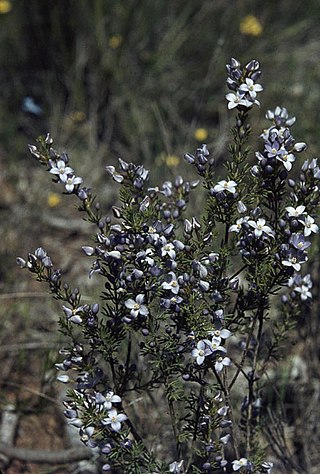
Cyanothamnus ramosus is a species of plant in the citrus family Rutaceae and is endemic to the southwest of Western Australia. It is an erect, mostly glabrous shrub with pinnate leaves with up to seven leaflets, and white, four-petalled flowers with blue or pale green backs.

Beyeria lechenaultii is a species of dioecious flowering plant in the spurge family, Euphorbiaceae, that is endemic to Australia.
Bossiaea smithiorum is a species of flowering plant in the family Fabaceae and is endemic to the south-west of Western Australia. It is a slender shrub with oblong to cylindrical leaves and orange-yellow and red or purple, pea-like flowers.

Daviesia flava is a species of flowering plant in the family Fabaceae and is endemic to Queensland. It is a glabrous shrub with linear or narrowly egg-shaped phyllodes, and uniformly yellow flowers.
Pomaderris graniticola is a species of flowering plant in the family Rhamnaceae and is endemic to eastern Australia. It is a shrub or small tree with hairy young stems, lance-shaped to elliptic leaves, and sparse panicles of yellow, white or cream-coloured flowers.
Stenanthemum argenteum is a species of flowering plant in the family Rhamnaceae and is endemic to a restricted part of Queensland. It is a shrub with hairy branches, lance-shaped to egg-shaped leaves with the narrower end towards the base, and heads of about seven hairy white, tube-shaped flowers.
Pimelea rupestris is a species of flowering plant in the family Thymelaeaceae and is endemic to eastern Australia. It is a shrub with hairy young stems, elliptic to egg-shaped leaves with the narrower end towards the base, and heads of white flowers that are either all male or all female.

Androcalva fragifolia is a species of flowering plant in the family Malvaceae and is endemic to the south-west of Western Australia. It is a straggling, prostrate shrub with glossy, broadly egg-shaped leaves, and creamy white flowers.
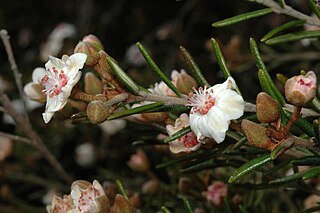
Ricinocarpos bowmanii, commonly known as western wedding bush or Bowman jasmine, is a species of flowering plant in the family Euphorbiaceae and is endemic to New South Wales. It is usually a monoecious shrub with linear to oblong leaves and three to six male flowers around each female flower.
Ricinocarpos brevis is a species of flowering plant in the family Euphorbiaceae and is endemic to inland Western Australia. It is a monoecious, densely-branched shrub with narrowly oblong leaves and male and female flowers arranged singly or in small groups.
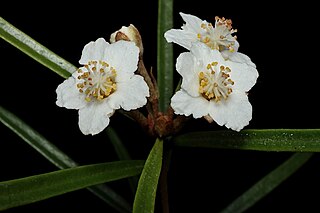
Ricinocarpos caniana is a species of flowering plant in the family Euphorbiaceae and is endemic to a restricted area of south-eastern Queensland. It is an erect monoecious or dioecious shrub with linear leaves and white flowers, arranged either singly, with two to five male flowers, or a single female flower surrounded by up to four male flowers.
Ricinocarpos crispatus is a species of flowering plant in the family Euphorbiaceae and is endemic to south-western Queensland. It is a monoecious or dioecious shrub with linear leaves and white flowers, arranged either singly, with two to four male flowers, or a single female flower surrounded by one or two male flowers.
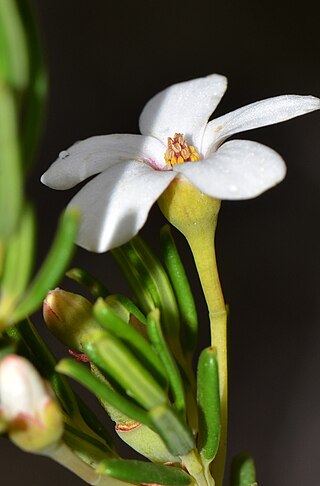
Ricinocarpos cyanescens is a species of flowering plant in the family Euphorbiaceae and is endemic to the south-west of Western Australia. It is a compact, monoecious shrub with narrowly oblong leaves and male and female flowers arranged singly or in small groups.
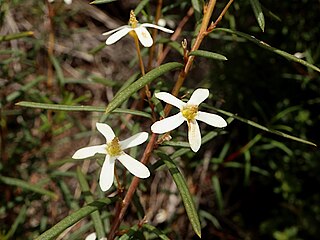
Ricinocarpos glaucus is a species of flowering plant in the family Euphorbiaceae and is endemic to the south-west of Western Australia. It is an erect, monoecious or dioecious shrub with linear or narrowly oblong leaves and male and female flowers arranged singly or in small groups.
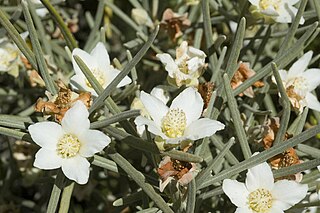
Ricinocarpos gloria-medii is a species of flowering plant in the family Euphorbiaceae and is endemic to the Northern Territory of Australia. It is a spreading, monoecious or dioecious shrub with linear leaves and male and female flowers arranged singly or in small groups.
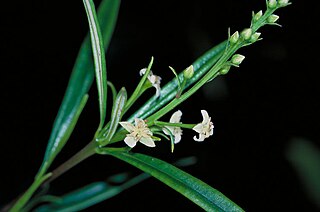
Ricinocarpos ledifolius is a species of flowering plant in the family Euphorbiaceae and is endemic to eastern Queensland. It is a monoecious or dioecious shrub or small tree with linear leaves and white flowers, arranged either singly, or with two or three female or two to six male flowers, or a single female flower surrounded by two male flowers.

Ricinocarpos linearifolius is a species of flowering plant in the family Euphorbiaceae and is endemic to eastern Australia. It is a monoecious or dioecious shrub with hairy young branchlets, linear leaves and white flowers, arranged either singly, with two to four male flowers, or a single female flower surrounded by up to three male flowers.












